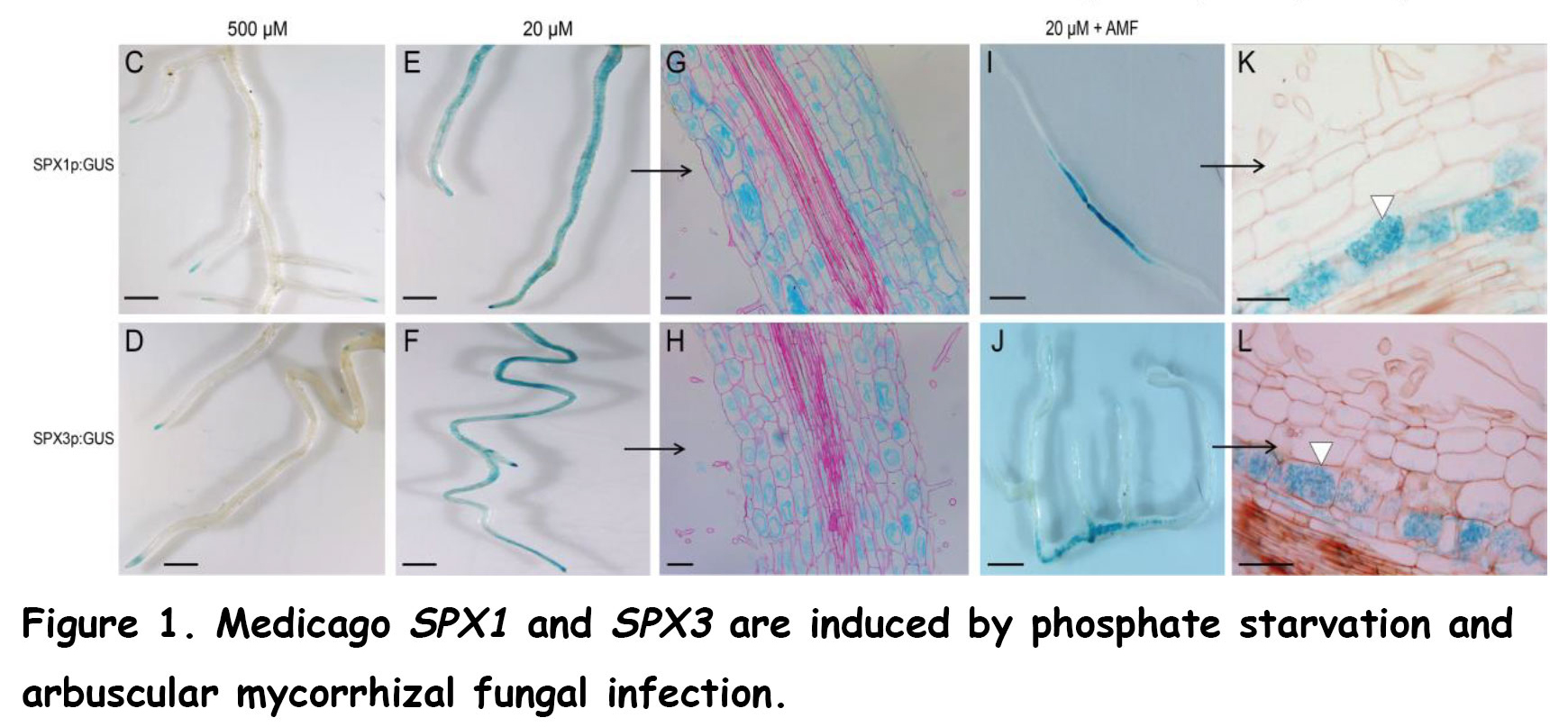博文
Plant Cell:苜蓿SPX1/3介导根组织丛枝菌根定殖和磷稳态
||
Medicago SPX1 and SPX3 regulate phosphate homeostasis, mycorrhizal colonization, and arbuscule degradation
第一作者:Peng Wang
第一单位:瓦赫宁根大学
第一通讯:Erik Limpens
Abstract
背景回顾:To acquire sufficient mineral nutrients such as phosphate (Pi) from the soil, most plants engage in symbiosis with arbuscular mycorrhizal(AM) fungi. Attracted by plant-secreted strigolactones, the fungi colonize the roots and form highly-branched hyphal structures called arbuscules inside inner cortex cells. The host plant must control the different steps of this interaction to maintain its symbiotic nature. 提出问题:However, how plants sense the amount of Pi obtained from the fungus, and how this determines the arbuscule lifespan, are far from understood. 主要发现:Here, we show that Medicago truncatula SPX-domain containing proteins SPX1 and SPX3 regulate root Pi starvation responses, in part by interacting with PHOSPHATE RESPONSE REGULATOR2, as well as fungal colonization and arbuscule degradation. 结果1-表达模式:SPX1 and SPX3 are induced upon Pi starvation but become more restricted to arbuscule-containing cells upon the establishment of symbiosis. This induction in arbuscule-containing cells is associated with the presence of cis-regulatory AW-boxes and transcriptional regulation by the WRINKLED1-like transcription factor WRI5a. 结果2-作用机制:Under Pi-limiting conditions, SPX1 and SPX3 facilitate the expression of the strigolactone biosynthesis gene DWARF27, which could help explain the increased fungal branching in response to root exudates. Later, in arbuscule-containing cells, SPX1 and SPX3 redundantly control arbuscule degradation. 结论:Thus, SPX proteins play important roles as phosphate sensors to maintain a beneficial AM symbiosis. 摘 要 
为了从土壤中获得充分的诸如磷酸盐(Pi)等矿质营养,大多数植物会与丛枝菌根(AM)真菌共生。真菌在受到由植物分泌的独脚金内酯的吸引,在植物的根上定殖,并在根的内皮层细胞内部形成一种称之为丛枝的高度分枝的菌丝结构。寄主植物必须控制这种相互作用的不同阶段,以维持其共生性质。然而,植物如何感知从真菌获得的Pi总量,以及这如何决定丛枝的持续年限,这些都还不是十分清楚。本文中,作者发现蒺藜苜蓿中含有SPX结构域的蛋白SPX1和SPX3,部分通过与PHR2的互作调控根的磷饥饿响应,以及真菌定殖和丛枝根降。Pi饥饿会SPX1和SPX3的表达,但在共生关系建立后,SPX1和SPX3蛋白仅在含有丛枝的细胞中表达。这种在含有丛枝细胞中的诱导,与顺式调控元件AW盒以及转录因子WRI5a的转录调控有关。在Pi限制条件下,SPX1和SPX3会促进独脚金内酯生物合成基因DWARF27的表达,这可能能够解释真菌分枝响应于根分泌物所引起的分枝增加表型。接着,在含有丛枝的细胞中,SPX1和SPX3控制丛枝的降解,并且存在功能冗余。因此,SPX蛋白作为磷酸盐传感器发挥重要作用,以维持有益的丛枝菌根共生。
doi: https://doi.org/10.1093/plcell/koab206
Journal: Plant Cell
Published date: September 01, 2021
https://blog.sciencenet.cn/blog-3158122-1302906.html
上一篇:Science:细胞膜通过磷脂酰甘油结合FT来介导植物的温度响应开花调控
下一篇:Current Biology:稳定同源多倍体减数分裂过程中染色体配对的交换干扰机制
全部作者的其他最新博文
- • Plant Physiology:CsMADS3促进柑果中的叶绿素降解和类胡萝卜素合成(华中农业大学)
- • Molecular Plant:LBD11-ROS反馈调节作用于拟南芥的维管形成层增殖和次生生长(浦项科技大学)
- • Science Advances:根结线虫通过调控植物的CLE3-CLV1模块,促进侵染进程(日本熊本大学)
- • Nature Communications:油菜素内酯参与植物营养生长期转变的分子机制解析(浙江农林大学)
- • Current Biology:光合作用产生的蔗糖驱动侧根“生物钟”(德国弗莱堡大学)
- • PNAS:花同源异型基因在叶中被抑制、花中被激活的分子机制(南卡罗来纳大学)